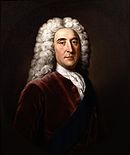1761 British general election
| ||||||||||||||||||||||||||||
All 558 seats of the House of Commons 280 seats were needed for a majority | ||||||||||||||||||||||||||||
|---|---|---|---|---|---|---|---|---|---|---|---|---|---|---|---|---|---|---|---|---|---|---|---|---|---|---|---|---|
| ||||||||||||||||||||||||||||
| ||||||||||||||||||||||||||||
The British general election, 1761, returned members to serve in the House of Commons of the 12th Parliament of Great Britain to be summoned, after the merger of the Parliament of England and the Parliament of Scotland in 1707. This was the first Parliament chosen after the accession to the throne of King George III. It was also the first election after George III had lifted the conventional proscription on the employment of Tories in government. The King prevented the Prime Minister, the Duke of Newcastle, from using public money to fund the election of Whig candidates, but Newcastle instead simply used his private fortune to ensure that his ministry gained a comfortable majority.
However, with the Tory party disintegrating, as a result of the end of their proscription providing them with new opportunities for personal advancement, and the loyalty they felt to the new King causing them to drift apart, there was little incentive for Newcastle's supporters to stay together. What little survived of Whig ideology was not compelling enough to maintain the party's coherence, and they split into a number of feuding factions led by aristocratic magnates, contributing to the political instability that would last until 1770.
The election was one of the most undemocratic in British history, with only around a hundred seats seeing a contested election.
Summary of the Constituencies
See British general election, 1796 for details. The constituencies used were the same throughout the existence of the Parliament of Great Britain.
Dates of Election
The general election was held between 25 March 1761 and 5 May 1761.
At this period elections did not take place at the same time in every constituency. The returning officer in each county or parliamentary borough fixed the precise date (see hustings for details of the conduct of the elections).
See also
References
- British Electoral Facts 1832-1999, compiled and edited by Colin Rallings and Michael Thrasher (Ashgate Publishing Ltd 2000). (For dates of elections before 1832, see the footnote to Table 5.02).

